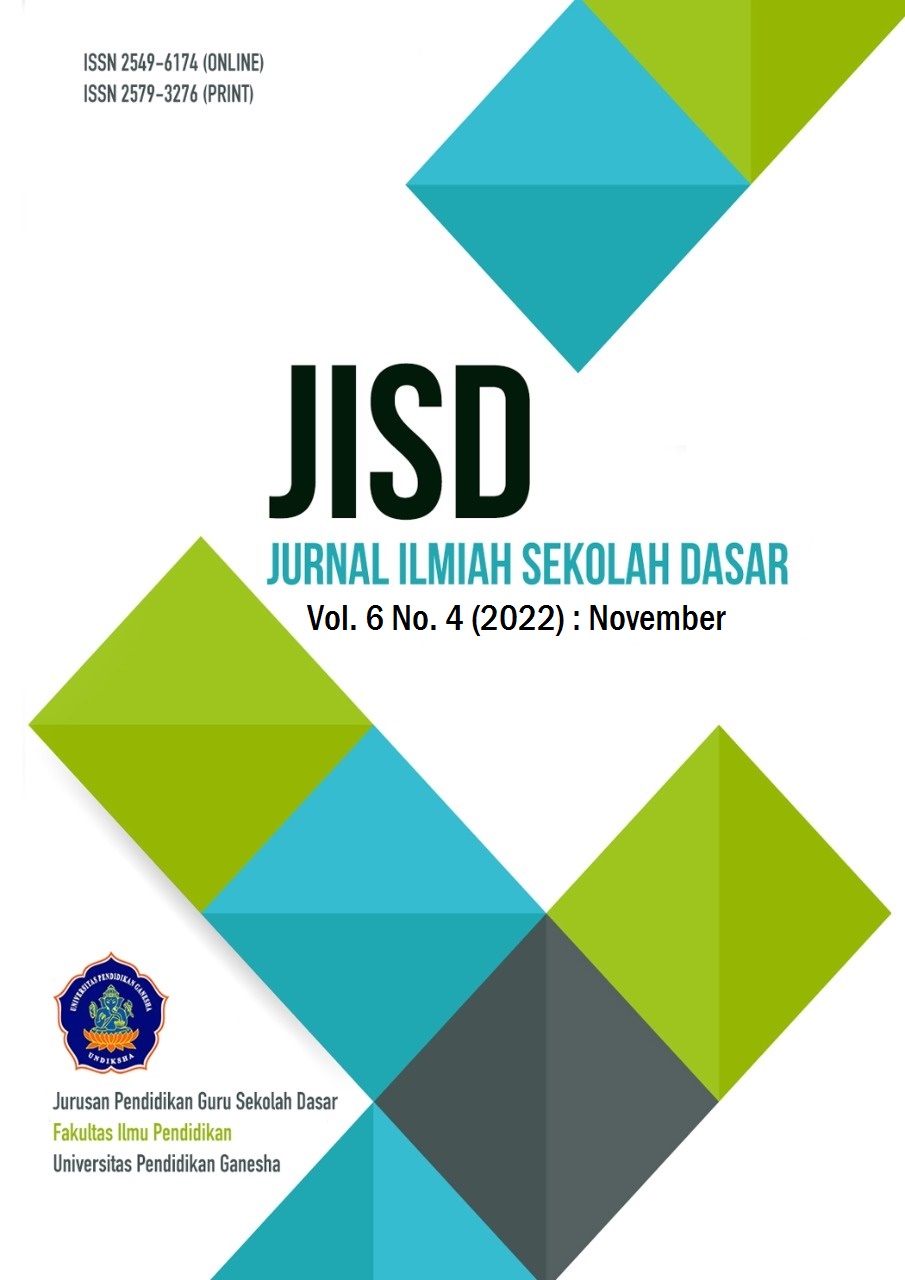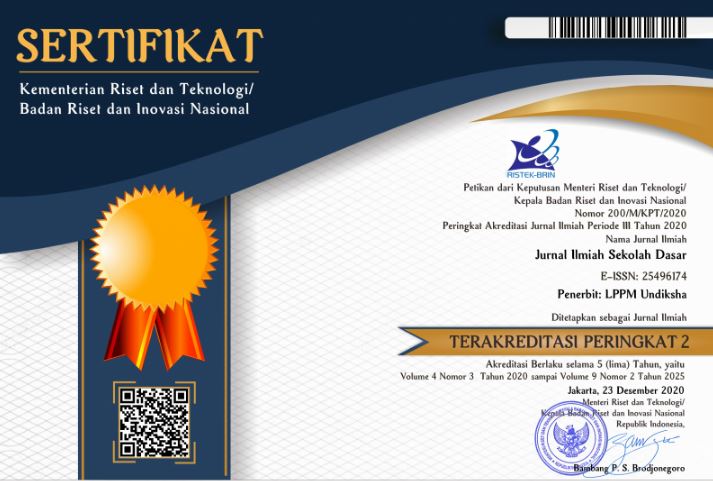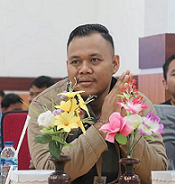Utilization of Visual Media in Thematic Learning in Elementary Schools
DOI:
https://doi.org/10.23887/jisd.v6i4.53744Keywords:
Visual Media, Learning Thematic, Elementary studentsAbstract
During the learning process students do not participate and do not study well. Teachers need better learning with steps to increase motivation. Visual media can be a solution to increase student motivation. The aim of this study is to analyses the use of visual media in learning thematic in grade VI along with the obstacles and solutions done by the teacher. The subjects of this study were students, teachers and principals of elementary school. This method uses descriptive qualitative method. Data collection techniques in this study use the form of observation, interviews and documentation. The validity test of the data used is technique triangulation and source triangulation. The research shows that the use of visual media in thematic learning in class VI consists of planning, implementation and evaluation. The obstacle that faced by teachers during the process of using visual media in thematic learning, namely learning media is incomplete or limited , lack of participation of parents and students which not enough understand theory which be delivered by teacher. The solution to overcome the problem of using visual media in thematic learning is to create interactive and attractive teaching materials and build communication between teachers and students.
References
Akuma, F. V., & Callaghan, R. (2019). Teaching practices linked to the implementation of inquiry-based practical work in certain science classrooms. Journal of Research in Science Teaching, 56(1). https://doi.org/10.1002/tea.21469. DOI: https://doi.org/10.1002/tea.21469
Andini, M., & Yunianta, T. N. H. (2018). The Development of Board game “The Adventure of Algebra” in the Senior High School Mathematics Learning. Al-Jabar : Jurnal Pendidikan Matematika, 9(2), 95–109. https://doi.org/10.24042/ajpm.v9i2.3424. DOI: https://doi.org/10.24042/ajpm.v9i2.3424
Aperta, M., Amini, R., Guru, P., & Dasar, S. (2021). Pengembangan Media Pembelajaran Tematik Terpadu Bebasis Kvisoft Flipbook Maker Pro di Kelas IV SD. Jurnal Pendidikan Tambusai, 5(1), 1024–1030. https://www.jptam.org/index.php/jptam/article/view/1066.
Apriati, L., Mulawarman, W. G., & Ilyas, M. (2021). Pengembangan Bahan Ajar Menyimak Berbasis Multimedia Interaktif pada Pelajaran Tematik dengan Tema “Indahnya Kebersamaan” untuk Siswa Kelas IV Sekolah Dasar. Diglosia: Jurnal Kajian Bahasa, Sastra, Dan Pengajarannya, 4(1), 13–22. https://doi.org/10.30872/diglosia.v4i1.73. DOI: https://doi.org/10.30872/diglosia.v4i1.73
Argina, A. W., Mitra, D., Ijabah, N., & Setiawan, R. (2017). Indonesian PISA Result: What Factors and What Should be Fixed? The 1st Education and Language International Conference Proceedings Center for International Language Development of Unissula, 69–79. http://lppm-unissula.com/jurnal.unissula.ac.id/index.php/ELIC/article/view/1212.
Asria, L., Sari, D. R., Ngaini, S. A., Muyasaroh, U., & Rahmawati, F. (2021). Analisis Antusiasme Siswa Dalam Evaluasi Belajar Menggunakan Platform Quizizz. Alifmatika: Jurnal Pendidikan Dan Pembelajaran Matematika, 3(1), 1–17. https://doi.org/10.35316/alifmatika.2021.v3i1.1-17. DOI: https://doi.org/10.35316/alifmatika.2021.v3i1.1-17
Baharuddin, B., & Kanada, R. (2017). Pengembangan Profesionalisme Guru Melalui In House Training. El-Idare: Jurnal Manajemen Pendidikan IslamJurnal Manajemen Pendidikan Islam, 3(2), 1–20. http://jurnal.radenfatah.ac.id/index.php/El-idare/article/view/3658.
Blevins, B. (2018). Teaching Digital Literacy Composing Concepts: Focusing on the Layers of Augmented Reality in an Era of Changing Technology. Computers and Composition, 50, 21–38. https://doi.org/10.1016/j.compcom.2018.07.003. DOI: https://doi.org/10.1016/j.compcom.2018.07.003
Castleberry, A., & Nolen, A. (2018). Thematic analysis of qualitative research data: Is it as easy as it sounds? In Currents in Pharmacy Teaching and Learning. https://doi.org/10.1016/j.cptl.2018.03.019. DOI: https://doi.org/10.1016/j.cptl.2018.03.019
Caswita. (2020). Forum Gumeulis: Upaya Peningkatan Kompetensi Guru dalam Menulis Karya Ilmiah di Kota Tasikmalaya. Andragogi: Jurnal Diklat Teknis Pendidikan Dan Keagamaan, 8(1), 418–429. https://doi.org/10.36052/andragogi.v8i1.122. DOI: https://doi.org/10.36052/andragogi.v8i1.122
Englund, C., Olofsson, A. D., & Price, L. (2017). Teaching with technology in higher education: understanding conceptual change and development in practice. Higher Education Research and Development, 36(1), 73–87. https://doi.org/10.1080/07294360.2016.1171300. DOI: https://doi.org/10.1080/07294360.2016.1171300
Falloon, G. (2020). From digital literacy to digital competence: the teacher digital competency (TDC) framework. Educational Technology Research and Development, 68(5), 2449–2472. https://doi.org/10.1007/s11423-020-09767-4. DOI: https://doi.org/10.1007/s11423-020-09767-4
Fansury, A. H., Januarty, R., Rahman, A. W., & Syawal. (2020). Digital Content for Millennial Generations: Teaching the English Foreign Language Learner on COVID-19 Pandemic. Journal of Southwest Jiaotong University, 55(3). https://doi.org/10.35741/issn.0258-2724.55.3.40. DOI: https://doi.org/10.35741/issn.0258-2724.55.3.40
Fatimah, A. S., & Santiana, S. (2017). Teaching in 21St Century: Students-Teachers’ Perceptions of Technology Use in the Classroom. Script Journal: Journal of Linguistic and English Teaching, 2(2), 125. https://doi.org/10.24903/sj.v2i2.132. DOI: https://doi.org/10.24903/sj.v2i2.132
Fitri, S. F. N. (2021). Problematika Kualitas Pendidikan di Indonesia. Jurnal Pendidikan Tambusai, 5(1), 1617–1620. https://www.jptam.org/index.php/jptam/article/view/1148.
Fitria, A. (2018). Penggunaan Media Audio Visual dalam Pembelajaran Anak Usia Dini. Cakrawala Dini: Jurnal Pendidikan Anak Usia Dini, 5(2). https://doi.org/10.17509/cd.v5i2.10498. DOI: https://doi.org/10.17509/cd.v5i2.10498
Fuadati, M., & Wilujeng, I. (2019). Web-Lembar Kerja Peserta Didik IPA Terintegrasi Potensi Lokal Pabrik Gula untuk Meningkatkan Rasa Ingin Tahu Peserta Didik. Jurnal Inovasi Pendidikan IPA, 5(1), 98–108. https://doi.org/10.21831/jipi.v5i1.24543. DOI: https://doi.org/10.21831/jipi.v5i1.24543
Gabriela, N. D. P. (2021). Pengaruh Media Pembelajaran Berbasis Audio Visual Terhadap Peningkatan Hasil Belajar Siswa Sekolah Dasar. Pendidikan Guru Sekolah Dasar, 2(1), 104–113. https://ummaspul.e-journal.id/MGR/article/download/1750/574. DOI: https://doi.org/10.33487/mgr.v2i1.1750
Gërguri-Rashiti, S., Ramadani, V., Abazi-Alili, H., Dana, L. P., & Ratten, V. (2017). ICT, Innovation and Firm Performance: The Transition Economies Context. Thunderbird International Business Review, 59(1), 93–102. https://doi.org/10.1002/tie.21772. DOI: https://doi.org/10.1002/tie.21772
Good, T. L. (2008). 21st century education: A reference handbook. 21st Century Education: A Reference Handbook, 1–513. https://doi.org/10.4135/9781412964012. DOI: https://doi.org/10.4135/9781412964012
Hastuti, A., & Budianti, Y. (2014). Pengaruh penggunaan media audio visual terhadap hasil belajar siswa pada mata pelajaran ipa kelas ii sdn bantargebang ii kota bekasi. Jurnal Pedagogik, 2(2), 33–38. https://doi.org/10.33558/pedagogik.v2i2.1244.
Hayashi, P., Abib, G., & Hoppen, N. (2019). Validity in qualitative research: A processual approach. Qualitative Report, 24(1), 98–112. https://doi.org/10.46743/2160-3715/2019.3443. DOI: https://doi.org/10.46743/2160-3715/2019.3443
Ikhsan, M., & Humaisi, M. S. (2021). Pemanfaatan Media Pembelajaran Audio Visual Dalam Mengembangkan Motivasi Belajar Siswa Pada Mata Pelajaran IPS Terpadu. Jurnal Ilmiah Ilmu Pengetahuan Sosial Indonesia, 1(1), 1–12. https://doi.org/10.21154/jiipsi.v1i1.45. DOI: https://doi.org/10.21154/jiipsi.v1i1.45
Indah, F., Pratama, P., Kristiyanto, A., & Widyastono, H. (2021). Character Values of Third Grade Slow Learner in Character Education at the Inclusive Elementary School. JPI (Jurnal Pendidikan Indonesia), 10(2), 345–352. https://doi.org/10.23887/JPI-UNDIKSHA.V10I2.28838.
Karo-Karo, I. R., & Rohani, R. (2018). Manfaat Media dalam Pembelajaran. AXIOM : Jurnal Pendidikan Dan Matematika, 7(1), 91–96. https://doi.org/10.30821/axiom.v7i1.1778. DOI: https://doi.org/10.30821/axiom.v7i1.1778
Krissandi, A. D. S., & Rusmawan, R. (2015). Kendala Guru Sekolah Dasar Dalam Implementasi Kurikulum 2013. Jurnal Cakrawala Pendidikan, 3(3), 457–467. https://doi.org/10.21831/cp.v3i3.7409. DOI: https://doi.org/10.21831/cp.v3i3.7409
Kumalawati, R., Murliawan, K. H., Yuliarti, A., Kartika, N. Y., & Noermelani, E. (2021). Utilization of information technology for learning in Covid-19 disaster conditions. IOP Conference Series: Earth and Environmental Science, 716(1). https://doi.org/10.1088/1755-1315/716/1/012001. DOI: https://doi.org/10.1088/1755-1315/716/1/012001
Lestari, F., Egok, A. S., & Febriandi, R. (2021). Pengembangan Bahan Ajar Matematika Berbasis Problem Based Learning Pada Siswa Sekolah Dasar. Jurnal Basicedu, 5(1), 394–405. https://doi.org/10.31004/basicedu.v5i1.628. DOI: https://doi.org/10.31004/basicedu.v5i1.628
Liu, J., Guo, S., Gao, R., & DiStefano, C. (2020). Investigating school children’s behavioral and emotional problems using pediatric symptoms checklist-17 in a structural equation modeling framework. School Psychology International, 41(3), 257–275. https://doi.org/10.1177/0143034320912301. DOI: https://doi.org/10.1177/0143034320912301
Long, N. T., & Van Hanh, N. (2020). A structural equation model of blended learning culture in the classroom. International Journal of Higher Education, 9(4). https://doi.org/10.5430/ijhe.v9n4p99 DOI: https://doi.org/10.5430/ijhe.v9n4p99
Md-Ali, R., Karim, H. B. B. A., & Yusof, F. M. (2016). Experienced primary school teachers’ thoughts on effective teachers of literacy and numeracy. Malaysian Journal of Learning and Instruction, 13(1), 43–62. https://doi.org/10.32890/mjli2016.13.1.3. DOI: https://doi.org/10.32890/mjli2016.13.1.3
Miles, B., Huberman, M., & Saldana, J. (2014). Qualitative Data Analysis: A Methods Sourcebook. SAGE Pub.
Natow, R. S. (2020). The use of triangulation in qualitative studies employing elite interviews. Qualitative Research, 20(2), 160–173. https://doi.org/10.1177/1468794119830077. DOI: https://doi.org/10.1177/1468794119830077
Ninawati, M., & Wahyuni, N. (2021). Efektivitas Media Pembelajaran Audio Visual Pada Pembelajaran Daring Terhadap Hasil Belajar IPA Siswa Kelas IV SDN Pademangan Barat 11 Jakarta Utara. TANGGAP : Jurnal Riset Dan Inovasi Pendidikan Dasar, 2(1), 64–73. https://doi.org/10.55933/tjripd.v2i1.273. DOI: https://doi.org/10.55933/tjripd.v2i1.273
Noble, H., & Heale. (2019). Triangulation in research, with examples. Evidence-Based Nursing, 22(3). https://doi.org/10.1136/ebnurs-2019-103145. DOI: https://doi.org/10.1136/ebnurs-2019-103145
Nurlaily, V. A., Soegiyanto, H., & Usodo, B. (2019). Elementary school teacher’s obstacles in the implementation of problem-based learning model in mathematics learning. Journal on Mathematics Education, 10(2), 229–238. https://doi.org/10.22342/jme.10.2.5386.229-238. DOI: https://doi.org/10.22342/jme.10.2.5386.229-238
Pranata, K., & Yulianti, A. (2021). Efektivitas Media Audio Visual Pada Pembelajaran Daring Terhadap Hasil Belajar Penjaskes Kelas V Sekolah Dasar. 7(2), 63–76. https://doi.org/10.36456/adiraga.v7i2.4570. DOI: https://doi.org/10.36456/adiraga.v7i2.4570
Qekaj-Thaqi, A., & Thaqi, L. (2021). The Importance of Information and Communication Technologies (ICT) during the COVID-19—Pandemic in Case of Kosovo (Analytical Approach of Students Perspective). OALib, 08(07), 1–15. https://doi.org/10.4236/oalib.1106996. DOI: https://doi.org/10.4236/oalib.1106996
Rahmatih, A. N., Maulyda, M. A., & Syazali, M. (2020). Refleksi Nilai Kearifan Lokal (Local Wisdom) dalam Pembelajaran Sains Sekolah Dasar: Literature Review. Jurnal Pijar Mipa, 15(2), 151–156. https://doi.org/10.29303/jpm.v15i2.1663. DOI: https://doi.org/10.29303/jpm.v15i2.1663
Rajendra, I. M., & Sudana, I. M. (2017). The Influence of Interactive Multimedia Technology to Enhance Achievement Students on Practice Skills in Mechanical Technology. Journal of Physics, 953, 1–5. https://doi.org/10.1088/1742-6596/953/1/012104. DOI: https://doi.org/10.1088/1742-6596/953/1/012104
Ranuharja, F., Ganefri, G., Fajri, B. R., Prasetya, F., & Samala, A. D. (2021). Development of Interactive Learning Media Edugame Using Addie Model. Jurnal Teknologi Informasi Dan Pendidikan, 14(1), 54–60. https://doi.org/10.24036/tip.v14i1.412. DOI: https://doi.org/10.24036/tip.v14i1.412
Renes, S. L., & Strange, A. T. (2010). Using Technology to Enhance Higher Education. Innovative Higher Education, 36(3), 203–213. https://doi.org/10.1007/s10755-010-9167-3. DOI: https://doi.org/10.1007/s10755-010-9167-3
Reyna, J., Hanham, J., & Meier, P. (2017). A taxonomy of digital media types for Learner-Generated Digital Media assignments. E-Learning and Digital Media, 14(6), 309–322. https://doi.org/10.1177/2042753017752973. DOI: https://doi.org/10.1177/2042753017752973
Saputro, S. D., & Setyawan, A. (2020). The Effectiveness Use of Virtual Reality Media in Physics Education of Solar System towards Cognitive Learning Outcomes. JPI (Jurnal Pendidikan Indonesia), 9(3), 390–400. https://doi.org/10.23887/jpi-undiksha.v9i3.23105 DOI: https://doi.org/10.23887/jpi-undiksha.v9i3.23105
Smaldino, S. E., Lowther, D. L., Russell, J. D., & Mims, C. (2008). Instructional technology and media for learning.
Sobry, M., & Sa’i, M. (2020). Penguatan Kompetensi Guru Melalui Pemanfaatan Media Sederhana Dan Modern. El-Tsaqafah : Jurnal Jurusan PBA, 19(1), 97–118. https://doi.org/10.20414/tsaqafah.v19i1.2347. DOI: https://doi.org/10.20414/tsaqafah.v19i1.2347
Starman, A. (2013). The case study as a type of qualitative research. Journal of Contemporary Educational Studies, 64(1), 28–43. https://www.researchgate.net/profile/A-Biba-Rebolj-2/publication/265682891_The_case_study_as_a_type_of_qualitative_research/links/54183f560cf25ebee988104c/The-case-study-as-a-type-of-qualitative-research.pdf.
Sugiyono. (2014). Metode Penelitian Pendidikan Pendekatan Kuantitatif, Kualitatif, dan R&D. Alfabeta.
Suni Astini, N. K. (2020). Tantangan Dan Peluang Pemanfaatan Teknologi Informasi Dalam Pembelajaran Online Masa Covid-19. Cetta: Jurnal Ilmu Pendidikan, 3(2), 241–255. https://doi.org/10.37329/cetta.v3i2.452. DOI: https://doi.org/10.37329/cetta.v3i2.452
Susanti, B. (2019). Penggunaan Media Pembelajaran Video Scribe Untuk Meningkatkan Motivasi Belajar Siswa Kelas V Madrasah Ibtidaiyah At-Taqwa Pinang. NATURALISTIC : Jurnal Kajian Penelitian Pendidikan Dan Pembelajaran, 3(2), 387–396. https://doi.org/10.35568/naturalistic.v3i2.399. DOI: https://doi.org/10.35568/naturalistic.v3i2.399
Susilawati, W. O., Widodo, H., & Sumarno, S. (2019). Strategy of Teachers in Suporting Environmentally Sustainable Development. Journal of Education and Learning (EduLearn), 13(2), 247–254. https://doi.org/https://doi.org/10.11591/edulearn.v13i2.12167. DOI: https://doi.org/10.11591/edulearn.v13i2.12167
Sutamin, N. W. (2019). Penggunaan Model Pembelajaran Small Group Work (SGW) dengan Media Audio Visual untuk Meningkatkan Prestasi Belajar Bahasa Indonesia. Jurnal Imiah Pendidikan Dan Pembelajaran, 3(2), 181–188. https://doi.org/10.23887/jipp.v3i2.18075. DOI: https://doi.org/10.23887/jipp.v3i1.17107
Syaifuddin, M. (2017). Implementasi Pembelajaran Tematik di Kelas 2 SD Negeri Demangan Yogyakarta. Tadris: Jurnal Keguruan Dan Ilmu Tarbiyah, 2(2), 139. https://doi.org/10.24042/tadris.v2i2.2142. DOI: https://doi.org/10.24042/tadris.v2i2.2142
Tinja, Y., Towaf, S. M., & Hariyono. (2017). Pengembangan Bahan Ajar Tematik Berbasis Kearifan Lokal Sebagai Upaya Melestarikan Nilai Budaya Pada Siswa Sekolah Dasar. Jurnal Pendidikan: Teori, Penelitian, Dan Pengembangan, 2(9), 1257–1261. https://doi.org/10.17977/jptpp.v2i9.9990.
Tuuri, K., & Koskela, O. (2020). Understanding Human–Technology Relations Within Technologization and Appification of Musicality. Frontiers in Psychology, 11(April), 1–14. https://doi.org/10.3389/fpsyg.2020.00416. DOI: https://doi.org/10.3389/fpsyg.2020.00416
Veletsianos, G., & Houlden, S. (2019). An analysis of flexible learning and flexibility over the last 40 years of Distance Education. Distance Education, 40(4), 454–468. https://doi.org/10.1080/01587919.2019.1681893. DOI: https://doi.org/10.1080/01587919.2019.1681893
Wahyuni, E. S., & Yokhebed, Y. (2019). Deskripsi Media Pembelajaran Yang Digunakan Guru Biologi Sma Negeri Di Kota Pontianak. Jurnal Pendidikan Informatika Dan Sains, 8(1), 32. https://doi.org/10.31571/saintek.v8i1.1105. DOI: https://doi.org/10.31571/saintek.v8i1.1105
Werdiningsih, T., Triyono, M. B., & Majid, N. W. A. (2019). Interactive multimedia learning based on mobile learning for computer assembling subject using the principle of multimedia learning (Mayer). International Journal of Advanced Science and Technology, 28(16), 711–719. https://www.researchgate.net/profile/Nuur-Wachid-Abdul-Majid/publication/342158818_Interactive_Multimedia_Learning_based_on_Mobile_Learning_for_Computer_Assembling_Subject_using_the_Principle_of_Multimedia_Learning_Mayer/links/5ee5a3c6299bf1faac55b70e/Int.
Wibawa, S. C. (2017). The Design And Implementation of An Educational Multimedia Interactive Operation System Using Lectora Inspire. Elinvo (Electronics, Informatics, and Vocational Education), 2(1). https://doi.org/10.21831/elinvo.v2i1.16633. DOI: https://doi.org/10.21831/elinvo.v2i1.16633
Winarto, W., Syahid, A., & Saguni, F. (2020). Effectiveness the Use of Audio Visual Media in Teaching Islamic Religious Education. International Journal of Contemporary Islamic Education, 2(1), 81–107. https://doi.org/10.24239/ijcied.Vol2.Iss1.14. DOI: https://doi.org/10.24239/ijcied.Vol2.Iss1.14
Yin, R. (2011). Applications of case study research. Sage Publication.
Yu, H., Liu, P., Huang, X., & Cao, Y. (2021). Teacher Online Informal Learning as a Means to Innovative Teaching During Home Quarantine in the COVID-19 Pandemic. Frontiers in Psychology, 12(June), 1–12. https://doi.org/10.3389/fpsyg.2021.596582. DOI: https://doi.org/10.3389/fpsyg.2021.596582
Downloads
Published
How to Cite
Issue
Section
License
Copyright (c) 2022 Aji Aji, Ali Imron Al ma'ruf, Djalal fuadi, Laili Etika Rahmawati, Endang fauziati

This work is licensed under a Creative Commons Attribution-ShareAlike 4.0 International License.
Authors who publish with the Journal Ilmiah Sekolah Dasar agree to the following terms:
- Authors retain copyright and grant the journal the right of first publication with the work simultaneously licensed under a Creative Commons Attribution License (CC BY-SA 4.0) that allows others to share the work with an acknowledgment of the work's authorship and initial publication in this journal.
- Authors are able to enter into separate, additional contractual arrangements for the non-exclusive distribution of the journal's published version of the work (e.g., post it to an institutional repository or publish it in a book), with an acknowledgment of its initial publication in this journal.
- Authors are permitted and encouraged to post their work online (e.g., in institutional repositories or on their website) prior to and during the submission process, as it can lead to productive exchanges, as well as earlier and greater citation of published work. (See The Effect of Open Access)










